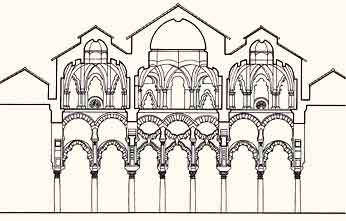With the Islamic conquest of large parts of Spain in the year 711, the Late Antique basilica of Córdoba was transformed into a mosque. After the only descendant of the Umayyads, Abd al-Rahmân I selected Córdoba as his capital and had himself proclaimed the emir of al-Andalus (Islamic Spain) in the mosque, the generations-long expansion of this enormous complex of buildings began.
Wilhelm Gail shows here a partial view of the most splendid and imaginative creation of Arab architecture, the Mezquita, which Caliph al-Hakam II commissioned on the day of his coronation in 961. The viewer finds himself in the front of the Mihrâb, the islamic centre of the mosque, and looks back across the main axis toward the former nave. Two storeys of overlapping arches emphasize the special status of this space, which, in contrast to the shadowy darkness of the prayer room below the wall of columns, obtains its own illumination from a gilded, ribbed dome.
In 1832-33, Wilhelm Gail became the first German painter to embark on a voyage of discovery to Spain, obtaining the inspiration for numerous pictures. He was particularly struck by the former Grand Mosque of Córdoba, as attested by further watercolours and an almost identical oil painting, which Ludwig I of Bavaria acquired in 1836 for the Neue Pinakothek in Munich, but which is sadly lost today.

